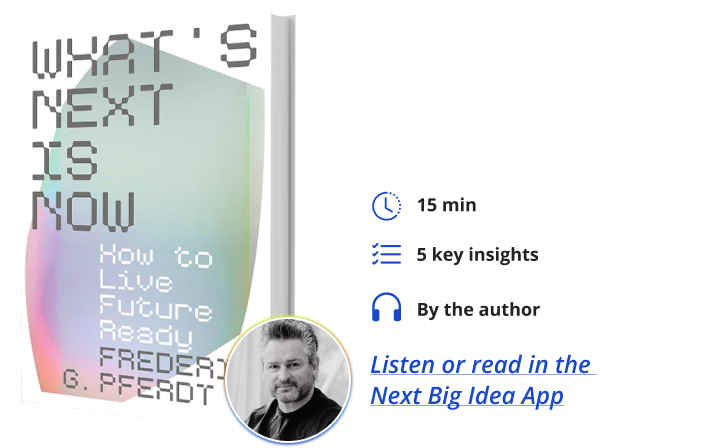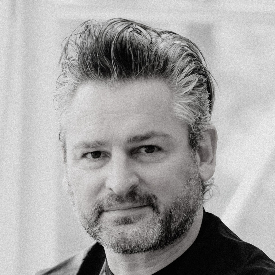Frederik Pferdt was Google’s first Chief Innovation Evangelist, where he shaped one of the most fabled creative cultures in the world. He founded Google’s Innovation Lab, training tens of thousands in developing cutting-edge ideas. He also taught classes on innovation and creativity at Stanford University for over a decade. Pferdt has worked with the United Nations, NASA, the NBA, and dozens of other organizations. His work has been highlighted in Fast Company, Harvard Business Manager, Der Spiegel, and BBC, among other media outlets.
Below, Frederik shares five key insights from his new book, What’s Next Is Now: How to Live Future Ready. Listen to the audio version—read by Frederik himself—in the Next Big Idea App.

1. The future shouldn’t be something that happens to you. It should be something you make happen.
I call myself a future optimist because I believe in running headlong toward the opportunities that the future holds instead of fearing the uncertainty the future brings. The formula is simple: The choices you make create your future. The greater the number of new and intentional choices you make, the more opportunities will reveal themselves. The more of these opportunities you pursue, the more control you have over what your future looks like.
On the flip side, when you don’t make new choices and deliberately avoid exploring ideas and experiences outside of what is familiar to you, then the choices that influence your future end up being made by someone else. How many people end up in careers that are unfulfilling or unsuited to them because they stop making choices that would take them down other paths?
Those same people feel the future is a far-off, mysterious force because of the way it seems to just happen to them. They feel like a passenger in a car driven by fate or luck or happenstance. No one has to be a passenger in that car. You don’t need to wait and see where the future is going to take you. You can start building the future you want right now.
If you use your imagination to engage with the possibilities that each moment presents, you will see a different landscape take shape in front of you. Your imagination is an immediate, intimate tool essential to the day-to-day crafting of your future that’s on or beyond the horizon. During the early days of the pandemic, I led a six-week innovation sprint with 25 leaders at Google to consider how the workplace could function in the future. Using metaphors such as “beehives” and “space stations” to envision different constructs, we developed a new vocabulary to describe a workplace that would support the diverse needs of our global workforce. Imagination was the best resource to answer a question that had once been a distant daydream and now was an urgent challenge.
The biggest risk you take in an uncertain and ambiguous world is to walk backward into the future, extrapolating from the past and assuming that what was true yesterday will be true tomorrow. At the same time, just casting your searching gaze into the distant future misses
the live wire of opportunity right in front of you. The future is something that you must actively shape using choices that arise through creativity and imagination.
2. Being ready for the future isn’t about technology. It’s about your mindstate.
While working at one of the leading tech companies in the world, I learned that success in the future doesn’t hinge on technology at all. What matters most is how mentally prepared you are to tackle problems and seize opportunities that present themselves at any given moment. This is your mindstate, the immediate perspective you have that perceptually and cognitively influences how you choose to act or react.
The future-ready mindstate fuels thoughts and behavior with optimism, openness, curiosity, experimentation, and empathy. When these dimensions of a future-ready mindstate are engaged, you see potential all around. If you see more choices, you make more choices, which means more opportunities.
Technology alone isn’t a ticket to the future. But your curiosity and experimentation with technology may create something that wasn’t there before. Maybe AI intimidates you, but you play with it a little, and the seed of an idea pops in your head. Your idea may not have anything to do with AI, but there it is, something new that may grow into an entirely different path forward.
“If you see more choices, you make more choices, which means more opportunities.”
In this way, these dimensions of your future-ready mindstate can prompt or influence dozens of choices you might make in a given day. Your openness or empathy may turn an ordinary social interaction with a stranger into a connection that alters their path or your own. Your optimism or curiosity can shape how you engage with even the trivial factors of your day, such as heavy traffic or an overstuffed email inbox. At every turn, you can use your future-ready lens to identify and make choices that were previously not accessible.
Technology doesn’t create the choices and opportunities that lead to your future. Your future-ready lens makes those choices visible. It’s not the “what” of technology, it’s the “who.”
3. Train your mind to expect the unexpected.
The past and present feel safe and familiar, while the ambiguity and uncertainty of the future cause anxiety. For the most part, this just amounts to being afraid of change, which is funny given that evolution has shown that change is happening all the time. It’s weird that we’re naturally resistant to change even though we’re a product of change. We’re built by change but not for change.
It’s not just evolution breathing down our necks. Today, change is accelerating at such an unprecedented rate that you can see it happening. It’s like an amusement park ride where the more it whips you round and round, the more desperately you cling to the safety bar that holds you in one place. How can you build a future out of new experiences and opportunities if your brain is telling you to resist change?
Recent studies in neuroplasticity have shown that our brains are capable of continuously adapting to new information and conditions. To train your mind to expect the unexpected, try this:
One morning, find a quiet space where you can sit comfortably. Close your eyes. Take deep, slow breaths in and out. Feel each breath centering your mind and calming your body. Then think through the details of the day ahead. Envision every hour unfolding exactly as planned. You smoothly move through each activity, and at the end of the day, you feel satisfied and in control.
Scroll back to the beginning of this same day and imagine things going sideways. You overslept. Now you’re running late to an important meeting and get a flat tire. A project you’ve been working on gets canceled. You get a text about a family member who urgently needs your care. You have to fill in for a colleague at a conference at the last minute. Picture your emotional and physical reaction to your sideways scenarios. Let yourself feel all the angst or discomfort they would provoke.
“Breathe in acceptance; breathe out resistance.”
As you contemplate each unexpected event, pause to take a breath. Breathe in acceptance; breathe out resistance. Acceptance in, resistance out. Now, think about the potential that may exist within each of your situations. A canceled project might make space for a rewarding creative pursuit. Caring for a loved one could deepen your relationship. A sudden travel opportunity might expand your professional prospects. Open your eyes.
Think about what happened when you shifted your perception of these events. They released their physical and emotional hold on and transformed from unpleasant surprises into life experiences to explore.
Now, do it in real time. As you go about your day, note when something—even the smallest thing—doesn’t go as expected. Each time, take a beat to acknowledge the hitch, then find what good might come of it. Every repetition of this exercise reinforces your ability to adapt in the face of change. Over time, your mind becomes naturally poised to catch whatever is tossed your way and incorporate it into the choices that become the steps toward your tomorrow.
4. If you’re stuck, open your eyes to better.
Many people rely on hope when thinking about what might happen next. Hope is nice, but it waits with its fingers crossed for something good to happen. Radical optimism, on the other hand, is an active, vigorous belief in the potential not for good but for better. The pursuit of better is about progress, not perfection. Innovators know that better is the result of constant, persistent iteration. The best innovators are not looking to hit the ball out of the park. They’re looking for the smallest degrees of better that will move their work to the next level.
When you orient yourself around better, every day is filled with infinite and immediate opportunities to succeed. The radical optimist is poised to seize these opportunities, creating a rhythm of iteration that hums on multiple levels throughout their day-to-day lives. It’s not just about seeing the glass as half full; it’s about realizing the potential that it can be filled.
Take Kalle Ryan, for example. He is one of the many “Future Readies” I trained and coached at
Google. For a long time while working at Google and later Meta, he joked that his corporate self was Bruce Wayne, but his creative self was Batman. For someone with a strong creative impulse, he knew that drawing a line between “work me” and “creative me” wasn’t right or healthy. He was running huge, impactful initiatives on the job, but inside, he felt profoundly stuck.
One day, he asked himself: What might be better if Batman came to work? From that day on, he saw his work entirely differently. He started asking: What is the creative way to look at this? What’s the creative way to articulate this? Where previously he solved problems in the expected way, now he saw the creative opportunity to find better in every task or project. Soon, he was coloring outside the lines every single day.
“When you orient yourself around better, every day is filled with infinite and immediate opportunities to succeed.”
Changing his focus dramatically altered the trajectory of his career. It turned out that Batman was just what his corporate function desperately needed. Kalle’s radical optimism is kind of a trust—he believes you have to trust that better is out there and be ready to do something with it. All you have to do is open your eyes to find it.
5. How do you want to be in the future?
Your future-ready mindstate drives you to continuously learn, adapt, innovate, and connect with people and your environment in ways that propel you toward your future. It pushes you to walk paths fueled by your aspirations and ensures you’re equipped to navigate the complexities of whatever lies ahead.
It’s not a question of what you want to do or who you want to be. It’s a question of how you want to be. This is the heart of it: How you are in your future will determine the impression—the “you-print”—you leave on this planet.
Will your you-print show what you believed in and what inspired you? Will it show that you were resilient and bold? Or that you tried to understand yourself and others? Will it show the positive impact you had on the people in your life story? Or that you were fulfilled by the experiences your choices led you to?
You have to check in with yourself daily to ensure that you are in this world as you intend to be. There’s no ideal “how to be” in your future. Your way will be a perfectly distinctive expression of everything true about you. If the choices you make each day reflect how you want to be, the future you build will be an appropriate legacy for how you live your life.
The future isn’t off in the distance—it’s right now. Living future-ready—with optimism, openness, curiosity, experimentation, and empathy—is exactly what you need to make the future you want to inhabit.
To listen to the audio version read by author Frederik Pferdt, download the Next Big Idea App today:





























